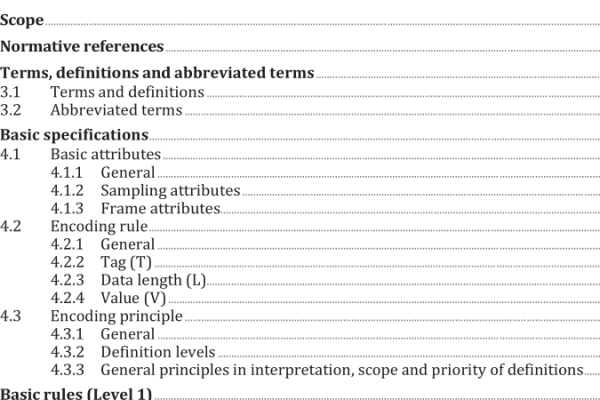ISO 22077-1:2022 pdf download – Health informatics — Medical waveform format — Part 1: Encoding rules.
1 Scope This document specifies how medical waveforms, such as electrocardiogram, electroencephalogram, spirometry waveform, etc., are described for interoperability among healthcare information systems. This document can be used with other relevant protocols, such as HL7, DICOM®, the ISO/IEEE 11073 series, and database management systems for each purpose. This is a general specification, so specifications for particular waveform types and for harmonization with DICOM®, SCP-ECG, X73, etc. are not given. This document does not include lower layer protocols for message exchange. For example, a critical real-time application such as a patient monitoring system is out of scope and this is an implementation issue. 2 Normative references There are no normative references in this document. 3 Terms, definitions and abbreviated terms 3.1 Terms and definitions For the purposes of this document, the following terms and definitions apply. ISO and IEC maintain terminology databases for use in standardization at the following addresses: — ISO Online browsing platform: available at https://www.iso .org/obp — IEC Electropedia: available at https://www.electropedia .org/ 3.1.1 frame waveform (3.1.5 ) encoding unit consisting of data blocks, channels (3.1.4) and sequences Note 1 to entry: The frame in this document is the same as waveform frame. 3.1.2 medical waveform time sequential data that are sampled by an A/D converter or transmitted from medical equipment 3.1.3 sampling data that are converted at a fixed time interval Note 1 to entry: The sampling in this document is the same as waveform sampling.
4.3.3.2 Multiple definitions Multiple definitions may be made for any item. Depending on the items, a new definition, an old definition or all definitions (such as for events) can be used multiple times. For example, setting the sampling frequency to 250 Hz overrides the initial value of 1 kHz. If multiple events occur, they are interpreted in definition order. 4.3.3.3 Later definition priority Each definition is interpreted in definition order. If an item has related definitions, definition should be made in due order. The default endianity is big-endian, so to use little-endian endianity the definition for little-endian must be designated. For example, before defining each channel, the number of channels should be defined. 4.3.3.4 Channel attributes definition order Before defining the attributes of a channel, the number of channels should be defined. If the number of channels is defined later, previous channel definitions are reset to the root definition including default values. 4.3.3.5 Root definition (general definition) and channel definition (definition per channel) The root definition is effective for all channels. The channel definition is effective only for the relevant channel and overrides the root definition. However, care should be taken because if a subsequent change to the root definition is made it will override the default content of the relevant channel for subsequent channel definitions. For example, if EEG is designated in the root definition, ECG designated for a channel in the channel definition overrides EEG.
ISO 22077-1:2022 pdf download – Health informatics — Medical waveform format — Part 1: Encoding rules






